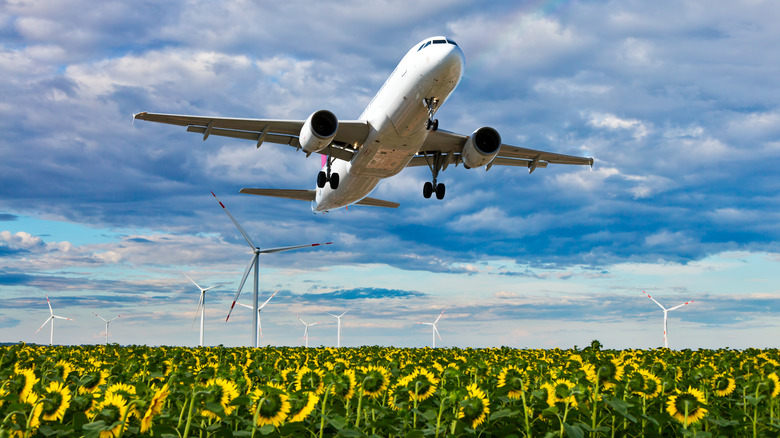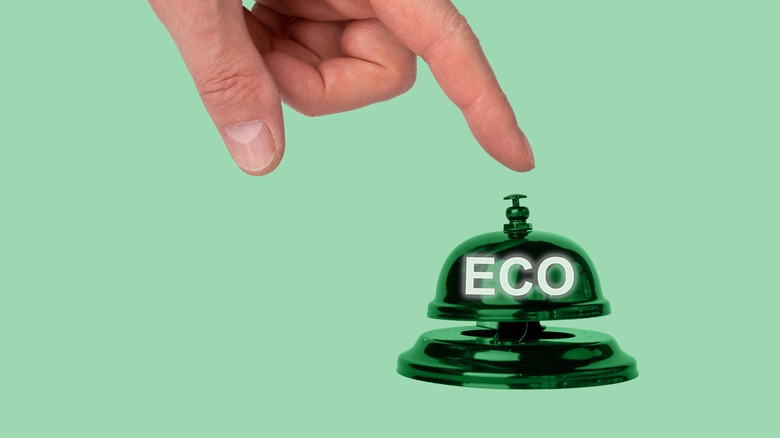How To Minimize Your Carbon Footprint When Traveling
Traveling allows us to embrace different cultures, explore exotic places, see iconic landmarks, step back into history, and appreciate a world larger than ourselves or our neighborhood. Traveling can expand our worldview, but that global consciousness comes with a responsibility.
In recent years, tourism has increasingly been scrutinized for its large carbon footprint. And while traveling can have positive effects, both societally and individually, there's no denying that traveling the world also harms it. According to Sustainable Travel International, the tourism industry accounts for roughly 8% of total global carbon emissions.
While that's a daunting stat, responsible traveling can help to minimize the negative impact of tourism on our planet. The landscape of the travel industry always shifts to accommodate traveler behavior. Do you remember reusable bottle-filling stations at airports 10 years ago? Doubt it. But over time, our change in behavior changed travel industry practices for the better.
Swearing off travel or "flight shaming" others isn't the answer. However, you can learn how to reduce carbon footprints while traveling, lessening your personal impact while also nudging the industry to do the same.
Make climate-minded choices when flying
According to Our World in Data, aviation travel makes up 2.5% of global carbon dioxide emissions. Although this may seem like a drop in the bucket, transportation is by far the leading contributor to traveling's carbon footprint, and remember that only a small percentage of the world's population flies.
Although flying may be necessary, whether it's due to distance or timeframe, you can make environmentally-friendlier choices when flying. For starters, choose an airline that's actually trying to operate greener. Recently, many airlines have made strides to improve fuel efficiency, utilize biofuels, and limit waste. Do your research.
Personal decisions when flying also really make an impact. Possibly spending more to fly direct and spending less to fly economy are both great ways to reduce your footprint. While business or first-class may be more comfortable, they also take up more space, so your footprint will be significantly larger. Packing light also reduces fuel consumption. This may seem trivial, but luggage adds significant weight to planes. Perhaps small, it's a personal way how to reduce carbon footprints while traveling.
And when it's not necessary to fly, consider alternative modes to travel. According to research conducted by the BBC, taking a bus or train over a flight — especially a short one — can significantly reduce CO2 emissions during your travels. Keep in mind, however, a solo car trip in a gas-powered vehicle can actually be worse than flying.
Choose (certified) eco-friendly hotels and tour operators
Similar to flying with greener airlines, choose accommodations that will offer you a more environmentally-friendly stay. In the U.S., the United States Green Building Council awards hotels with Leadership in Energy and Environmental Design (LEED) certifications for their eco-friendly operations and design.
To become LEED-certified, hotels are evaluated on a range of environmental metrics, such as energy use, waste management, and greenhouse gas emissions. Depending on performance, the hotel may receive a silver, gold, or platinum classification of LEED certification. Although eco-friendly is an attractive marketing angle, you're assured the hotel is actually environmentally friendly if it's LEED certified.
When traveling abroad, similar certifications exist around the world. For example, The Global Sustainable Tourism Council (GSTC) sets standards for hotels and tour operators. To receive a certification from the council, hotels and tour providers must meet certain criteria related to environmental impact, sustainability planning, benefits to local communities, and enhancing cultural heritage. By choosing a GSTC-certified business, you can reduce your carbon footprint while supporting the beneficial aspects of tourism.
Conserve energy during your stay
After choosing environmentally-friendly accommodations, your personal behavior while staying will also dictate the size of your carbon footprint. When we stay at a hotel, we can lose sight of the financial and environmental impact of our actions. We may be more likely to leave the lights on, run the A/C on high, or take extra-long showers when staying somewhere other than our home.
Hotels consume a lot of energy to operate, but if you behave like you're paying the energy bill, you can help mitigate that consumption. Also, while we may enjoy the pampering and creature comforts of a hotel stay, do you really need the room cleaned daily? Or new towels each day? Laundry services require huge amounts of both water and energy. By simply placing a "Do Not Disturb" sign on your door — foregoing daily cleanings — you can really cut down on unnecessary energy expenditure.
Eat and shop local
Deliciously simple, the food choices you make while traveling also make a difference regarding your carbon footprint. Whenever possible, you should try to eat local cuisine. First, eating local cuisine is one of the greatest parts of travel, but secondly, the process of shipping food is a large contributor to the industry's carbon emissions. When you choose a farm-to-table restaurant or a family-owned food stall that serves local ingredients, you eliminate greenhouse emissions created by shipping and storing food. You'll also support local communities while expanding your food palate. What's better than trying authentic international cuisine?
In the same vein, if you want a souvenir to take home, opt to buy something that's made locally versus a mass-produced trinket. Buying that hand-crafted souvenir from a local basket weaver or woodworker is a lot better for the environment than grabbing something made in a factory and imported.
Travel for longer periods of time
Finally, for those with a passion to travel, good news! By planning longer trips, you can significantly reduce your travel-related carbon footprint. Since transportation is the largest contributor to travel industry emissions, slow travel is a lot better for the environment.
For example, take a month-long journey to explore France and Spain from the U.S. instead of crisscrossing the world to visit both countries at different times. By slowly traveling, you'll spend less time rushing around (and producing CO2) and more time immersed in new towns and regions. Not to mention that your month-long trip eliminates the need for two extra trans-Atlantic flights.
If you apply these five tips and still feel a bit guilty once returning home, you can always purchase carbon offsets. You can find online carbon footprint calculators that estimate how much CO2 you produce through your travels. By buying carbon offsets, you help support organizations and projects that work to reduce emissions. While it's not a perfect solution, neither is choosing not to travel. Exploring and understanding our world helps inspire us to protect it.





